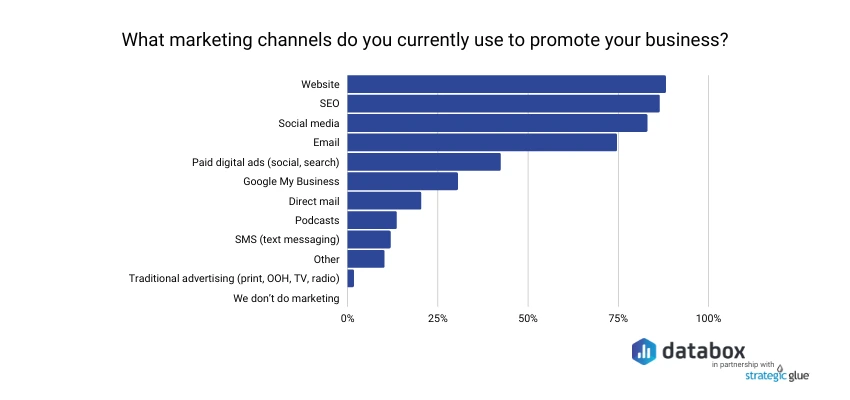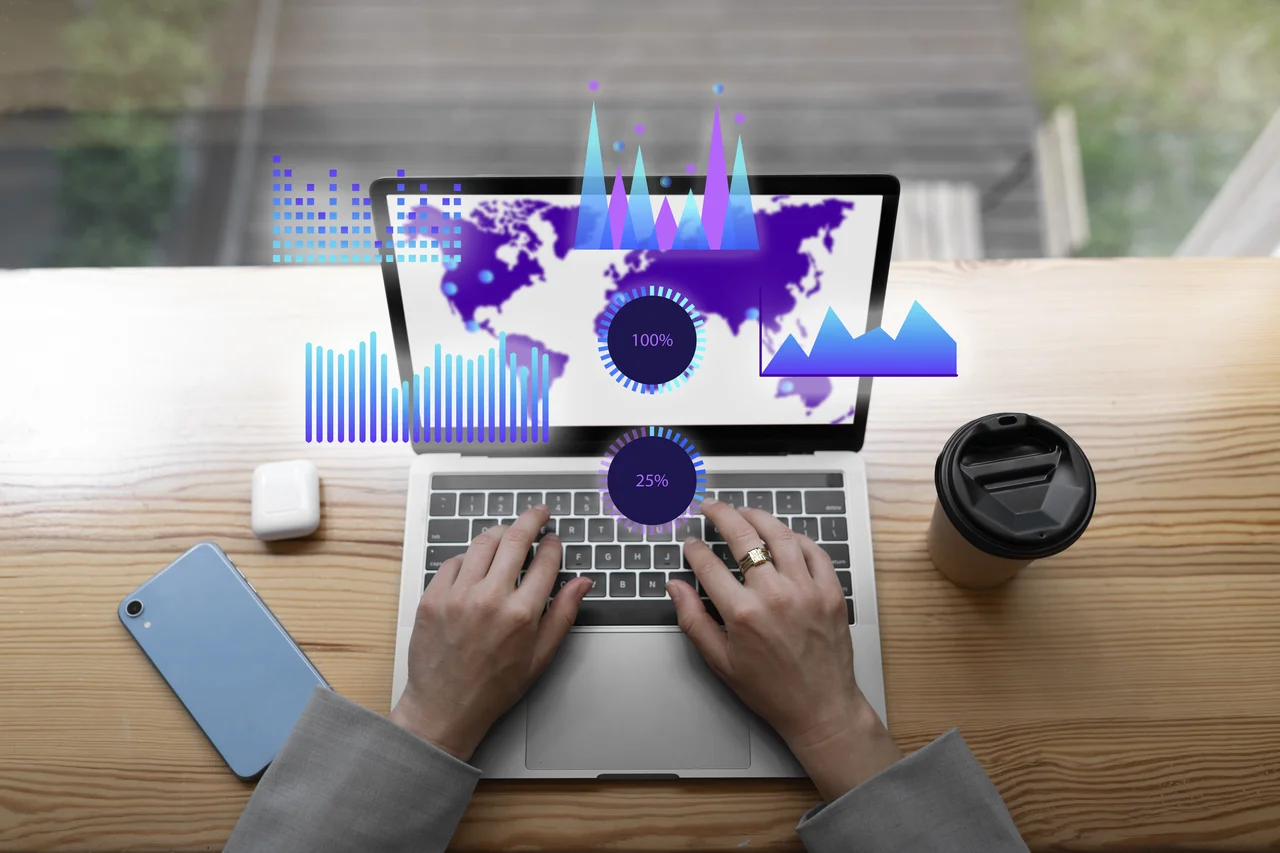Listen to article
In today’s rapidly evolving marketing landscape, staying ahead means not just keeping up with trends but also understanding which strategies are genuinely effective and which ones are yesterday’s news. Are you maximizing your marketing efforts, or are you stuck in a rut, relying on the same old tactics while overlooking hidden opportunities?
It’s time to rethink your marketing mix. While some channels are shining stars, others are often ignored, and many popular strategies are simply overused. This article dives into the most overused and underrated marketing channels based on recent statistics, revealing the tactics that can truly set you apart from the competition. Let’s explore how to unlock growth potential by focusing on high-impact strategies.
Blogging and SEO for Organic Visibility

Source: Thrive Themes
Many businesses focus heavily on social media, potentially overlooking the substantial impact of SEO and the value of blogging. While social media is valuable for engagement and brand awareness, SEO drives significantly more traffic and can be a more sustainable strategy. Blogs also remain a highly valuable asset for B2B marketers for organic growth and establishing thought leadership.
- SEO drives over 1,000% more traffic than organic social media. Source
- 63.4% of US web traffic referrals originate from Google, emphasizing the importance of a Google-first organic search strategy. Source
- 93% of online interactions begin with a search engine. Source
- Companies that maintain a blog experience a 55% increase in website visitors, generate 97% more inbound links, and achieve a 434% boost in indexed pages. Source
- Over half of marketers (53%) prioritize blog content creation as their top inbound marketing strategy. Source
Key Takeaway
SEO and blogging remain critical components of digital marketing, driving significantly more traffic than social media. With the majority of online interactions starting with a search engine, prioritizing SEO and creating valuable blog content can lead to increased visibility and sustainable growth.
Pro Tip:
Develop a comprehensive SEO strategy that includes keyword research, content optimization, and link building to maximize your online presence. To maximize the impact of your B2B website strategies, focus on creating high-quality, SEO-optimized content that addresses the specific needs and pain points of your target audience. Focus on creating evergreen content that remains relevant over time to maximize the long-term benefits of your blogging efforts.
LinkedIn: The Undisputed Leader in B2B Marketing and the Untapped Power of Video
LinkedIn has solidified itself as the premier social media platform for B2B marketers, and for good reason. Its professional environment, targeted networking, and data-driven ad options make it an indispensable tool in any B2B marketing strategy. Yet, while its dominance is clear, one area where many marketers fall short is leveraging the full potential of video content—a format that consistently outperforms other post types in engagement and reach on LinkedIn. As video continues to dominate the digital landscape, integrating it effectively into your LinkedIn strategy can be the competitive edge your brand needs.
- 84% of B2B marketers regard LinkedIn as the most valuable platform for their marketing efforts. Source
- 85% of B2B marketers affirm that LinkedIn consistently delivers the best value among social platforms. Source
- By comparison, only 28% find Facebook valuable, with 22% for YouTube and 21% for Instagram, showing LinkedIn’s superior positioning. Source
- Platforms like Twitter (7%) and TikTok (3%) lag far behind in value for B2B marketers. Source
- Globally, people spend an average of 145 minutes per day on social media, making it a vital space for connecting with your audience. Source
- LinkedIn users are 20 times more likely to share a video than any other type of post. Source
- Videos optimized for silent viewing on LinkedIn are 70% more likely to be watched until the end. Source
- 69% of marketers invest in video ads as a core part of their campaigns, underscoring the format’s effectiveness. Source
Key Takeaway
LinkedIn offers a unique opportunity for brands to generate high-value leads and build thought leadership, but simply having a presence isn’t enough. The data speaks for itself—video has tremendous power to amplify your content’s performance on the platform, driving higher engagement and shares. With professional audiences increasingly spending time on social platforms, adopting video content, particularly optimized for LinkedIn’s user behavior (e.g., silent viewing), can help your brand stand out in a crowded space.
Pro Tip:
Want to elevate your LinkedIn game? Focus on creating succinct, visually compelling video content that aligns with your audience’s professional interests. Use subtitles and focus on providing actionable insights or solutions that resonate with decision-makers. Consistently testing video formats and analyzing performance will ensure your strategy stays ahead of the curve.
Marketing Gems: Podcasts and Microsites
Amid the buzz around social media, email marketing, and SEO, innovative channels like podcasts and microsites quietly offer some of the most targeted and impactful ways to engage audiences. These platforms, while often overlooked, present a golden opportunity to build deeper connections with niche groups, especially as modern consumers crave personalized and value-driven experiences. By exploring these avenues, marketers can go beyond the noise of saturated platforms and create meaningful touchpoints that foster trust and brand loyalty.
- Podcast advertising spending in the U.S. is projected to exceed $2.5 billion in 2024, reflecting the surging popularity of podcasts. Source
- 74% of marketers report that podcasts are most effective during the early stages of lead generation. Source
- Nearly half of marketers (49%) use podcasts as part of their lead generation strategies. Source
- While 89% of marketers rely on organic social media, 84% use corporate blogs, and 71% lean on email newsletters, far fewer incorporate digital events (40%), podcasts (27%), or microsites (26%). Source
Key Takeaway
Podcasts and microsites remain underexploited despite their ability to create highly targeted engagement, especially during key phases like lead generation and awareness-building. Unlike broader channels, these platforms allow brands to speak directly to niche audiences, giving them an edge in positioning themselves as industry thought leaders. With podcast consumption and advertising spending continuing to skyrocket, there’s no better time to explore this intimate medium. Likewise, a well-crafted microsite can offer a focused and immersive experience for key campaigns, product launches, or educational content.
Pro Tip:
To maximize digital marketing ROI, tailor your content to your audience’s interests and needs. For podcasts, invite industry experts or clients to discuss trending topics or challenges your audience faces. When creating microsites, make them interactive and resource-rich to keep visitors engaged and coming back for more.
Data in Marketing Strategies

Source: Databox
Amid the rapid expansion of marketing tools and technologies, data has become the most valuable resource for brands striving to outpace competitors. Yet, many organizations overlook or underutilize this goldmine of insights, leaving significant growth potential untapped. By failing to harness data strategically, businesses risk falling behind in understanding customer behavior, measuring ROI, and creating personalized experiences that resonate.
- Less than 40% of marketers source content ideas from keyword analysis, illustrating missed opportunities to align content with audience demand. Source
- A staggering 87% of marketers acknowledge that data is the most underutilized asset within their company. Source
- Nearly 44% of businesses lack a quantitative grasp of their marketing’s impact, exposing a critical gap in ROI measurement systems. Source
Tapping into data-driven insights is no longer just a competitive edge—it’s a necessity. The numbers reveal that many brands are leaving growth potential on the table by not integrating data effectively into their strategies. Whether it’s through identifying high-performing keywords, tracking campaign performance, or using analytics to refine customer segmentation, data can unlock unprecedented levels of clarity and efficiency.
Pro Tip:
Take a phased approach to becoming a data-driven organization. Start small by focusing on one or two key metrics tied directly to your business goals, and gradually expand to more sophisticated analytics as your team gains confidence and expertise.
Cost of Neglected Content Marketing Efforts
In a world flooded with digital noise, creating content for the sake of it is no longer a viable strategy. The real challenge lies not just in producing content but ensuring it’s impactful, discoverable, and actually used. Yet, many brands fall into the trap of churning out material that ultimately collects dust, representing a squandered investment of time, budget, and creativity. To truly maximize ROI, brands must take a more strategic approach to content creation and utilization.
- A shocking 60% to 70% of the content produced by B2B marketers goes unused. Source
- 58% of the content provided to customers is considered hollow and meaningless. Source
- Research shows that 93% of content on B2B websites receives no backlinks from other sites. Source
- Only 2% of articles created by B2B brands generate 75% of the social shares in the space. Source
Key Takeaway
This data reveals a sobering reality—most content efforts fall flat, leaving businesses with minimal returns for their hard work. Instead of a “more is better” mindset, brands should prioritize meaningful, well-targeted content that speaks directly to their audience’s specific needs and challenges. A strong B2B website strategy can play a critical role in ensuring that your content aligns with user intent and drives measurable results.
Pro Tip:
Audit your existing content regularly to identify gaps, redundant materials, and high-performing assets. Repurpose or refresh top-performing content for new platforms or formats to extend its lifecycle and reach. Using tools like SEMrush or Ahrefs can also help identify untapped SEO opportunities while amplifying your best work.
Finding the Right Balance: Traditional Marketing Meets PPC and Emerging Digital Channels
In the ever-competitive B2B marketing landscape, it’s easy to default to “safe bets” like traditional advertising or high-performing PPC channels. However, such over-reliance often comes at the expense of untapped opportunities in other innovative digital spaces. A well-rounded strategy involves not just allocating budgets but also assessing performance regularly to maximize ROI while exploring new avenues to reach your audience effectively.
- 69% of B2B marketers globally plan to prioritize video content marketing in 2024. Source
- 21% of marketers see digital events as a key investment area. Source
- 47% of marketers are increasing funding for in-person events. Source
- 45% of B2B marketers expect their content marketing budgets to grow in 2024. Source
- Facebook and Google Ads are the top-performing paid ad channels in terms of ROI. Source
- Paid media or PPC drives two times the website traffic compared to SEO. Source
- 62% of marketers increased their PPC budgets last year, signaling a growing emphasis on paid campaigns. Source
- 72% of companies haven’t reviewed their ad campaigns in over a month, leading to inefficiencies and wasted ad spend. Source
Key Takeaway
Marketers who lean too heavily on PPC or traditional channels risk missing out on better-rounded strategies that leverage emerging platforms and diverse content types. While PPC offers immediate results, failing to optimize campaigns regularly can erode budgets and ROI—especially when ad reviews are left unchecked for months. Similarly, while in-person events and videos offer a compelling way to connect, they shouldn’t exclude investments in new trends like digital events or interactive marketing tools.
For businesses looking to balance traditional and digital channels, exploring full-service marketing solutions can be an effective way to streamline efforts. These services help integrate diverse marketing efforts, ensuring consistency and efficiency across everything from paid ads to content strategies.
Pro Tip:
Don’t just spread your budget across channels—prioritize flexibility and constant optimization. Build a habit of conducting PPC audits at least once a month to spot wasteful spending and strengthen ad performance. Simultaneously, experiment with rising digital formats like webinars or immersive content while refining your traditional channels to resonate with today’s dynamic buyer journeys. With the right mix, you can develop a campaign ecosystem that delivers both short-term wins and long-term growth.
When Content Marketing Fails: Addressing Overused Tactics and the Importance of Format Variety
Many marketers struggle with driving traffic and generating leads through content marketing, indicating that some tactics are overused or ineffective. It’s also important not to over-rely on familiar channels and to diversify your approach. To improve results, it’s essential to create high-quality, targeted content and stay informed about competitor strategies.
- 63% of marketers report that driving traffic and generating leads is the biggest challenge for content writers. Source
- 72% of online marketers view creating high-quality content as the most efficient way to boost their sites on organic search. Source
- A significant 40% of B2C content marketers don’t assess their competitors more than once a year. Source
- Scaling content production is a common challenge, with 49% of content marketers admitting they don’t repurpose content enough. Source
- In the past year, the percentage of B2B marketers who found creating the right content for their audience challenging decreased from 57% to 40%, suggesting improvements in content targeting.
- Fewer marketers now see SEO optimization (35%, down from 45%) and creating quality content (27%, down from 44%) as top challenges, possibly due to recent SEO advancements.
- The top 5 formats used by B2B marketers for content distribution are email (93%), social media (92%), blog posts (79%), real-life and in-person events (56%), and virtual events and webinars (55%). Source
- Successful B2B companies and agencies use all 5 of these formats to distribute their content effectively. Source
- Less successful B2B brands use only 4 formats to distribute their content, leading to negative results. Source
- 77% of B2B agencies and companies offer an email newsletter as a major part of their content marketing strategy. Source
- In 2019, 84.5% of American companies with 100 or more employees utilized digital content marketing strategies, while 87% of B2B companies used digital content marketing in the same year. Source
Key Takeaway
Creating high-quality, targeted content and staying informed about competitor strategies are crucial for content marketing success. While challenges in SEO optimization and content creation have decreased, driving traffic and generating leads remain significant hurdles. While email and social media remain essential, relying solely on these channels can lead to saturation and missed opportunities.
Pro Tip:
Regularly analyze your content performance and adapt your strategy to ensure it aligns with your audience’s needs and preferences. Experiment with emerging channels and formats to stand out from the competition and engage your audience in new and innovative ways.
Conclusion
The landscape of marketing channels is as dynamic as ever, with evidence pointing to both the untapped opportunities and the pitfalls of sticking to overused tactics. From the dominance of LinkedIn in B2B marketing to the rising potential of podcasts and microsites, it’s clear that diversification is key to standing out in a crowded digital space. Meanwhile, high-ROI strategies like SEO and blogging continue to prove their enduring value, driving sustainable traffic and engagement over time. However, the growing reliance on AI tools and data-driven insights also highlights a pivotal shift—marketers who fail to harness these technologies risk falling behind.
The statistics also reveal the high cost of underutilized efforts, from wasted content to poorly optimized PPC campaigns. Success in today’s marketing environment requires a delicate balance: leveraging proven strategies while staying agile enough to adapt to emerging trends. Whether you’re experimenting with video content on LinkedIn or refining your keyword analysis for SEO, the goal remains the same—connecting with your audience in meaningful and impactful ways.
Ready to boost your traffic and grow your website? Your customers are looking for you, and our SEO services or our PPC services can help you be found across search engines. Let’s unlock your brand’s full potential together.
About The Most Overused and Underrated Channels in Marketing Today
This guide was written by the Scopic Studios team and reviewed by Araksya Hakobjanyan, SEO Lead at Scopic Studios.
Scopic Studios delivers exceptional and engaging content rooted in our expertise across marketing and creative services. Our team of talented writers and digital experts excel in transforming intricate concepts into captivating narratives tailored for diverse industries. We’re passionate about crafting content that not only resonates but also drives value across all digital platforms.
Note: This blog’s feature image is sourced from Freepik.































































































































































































































